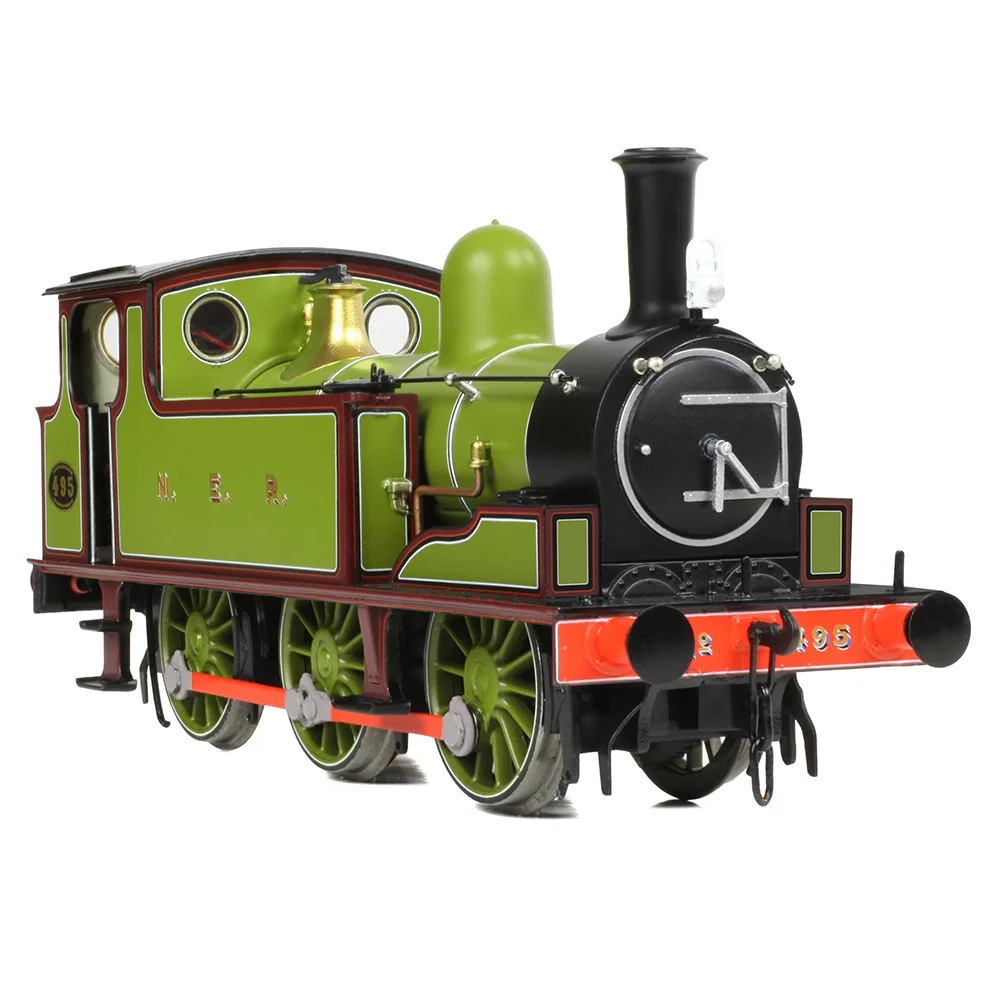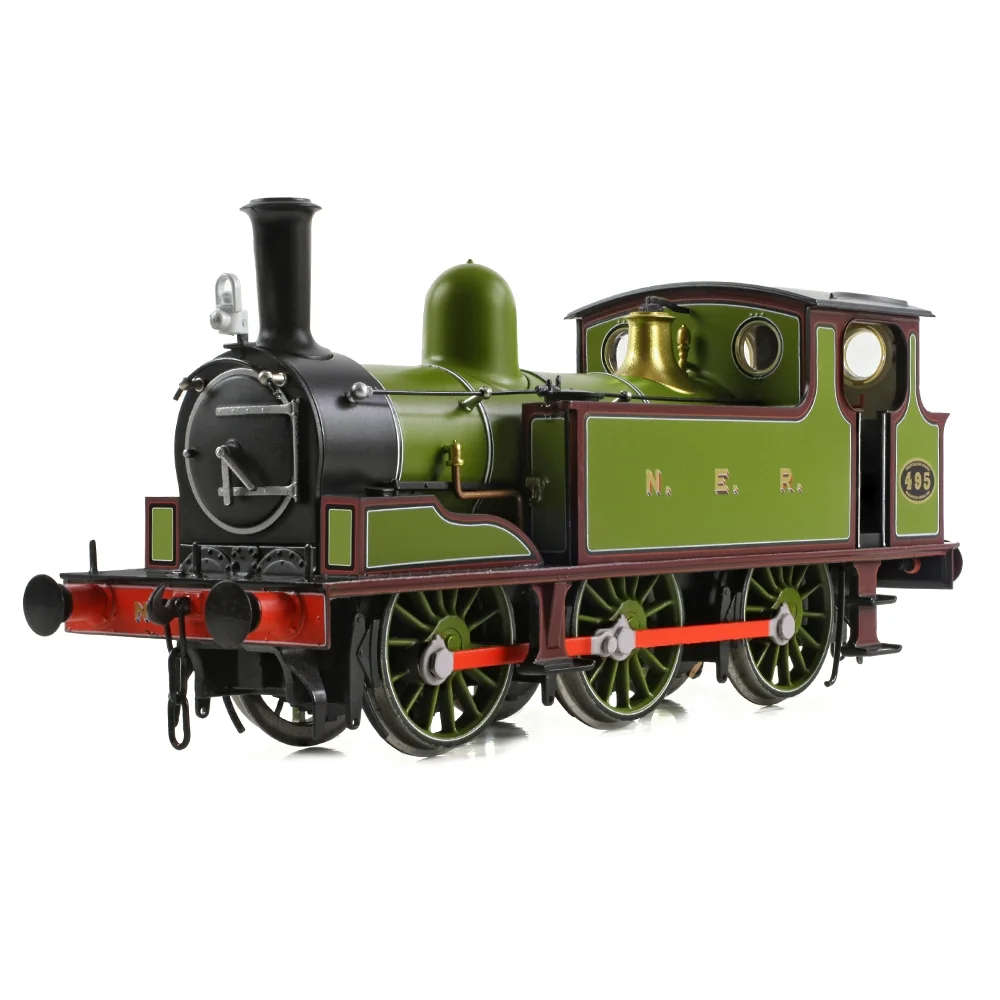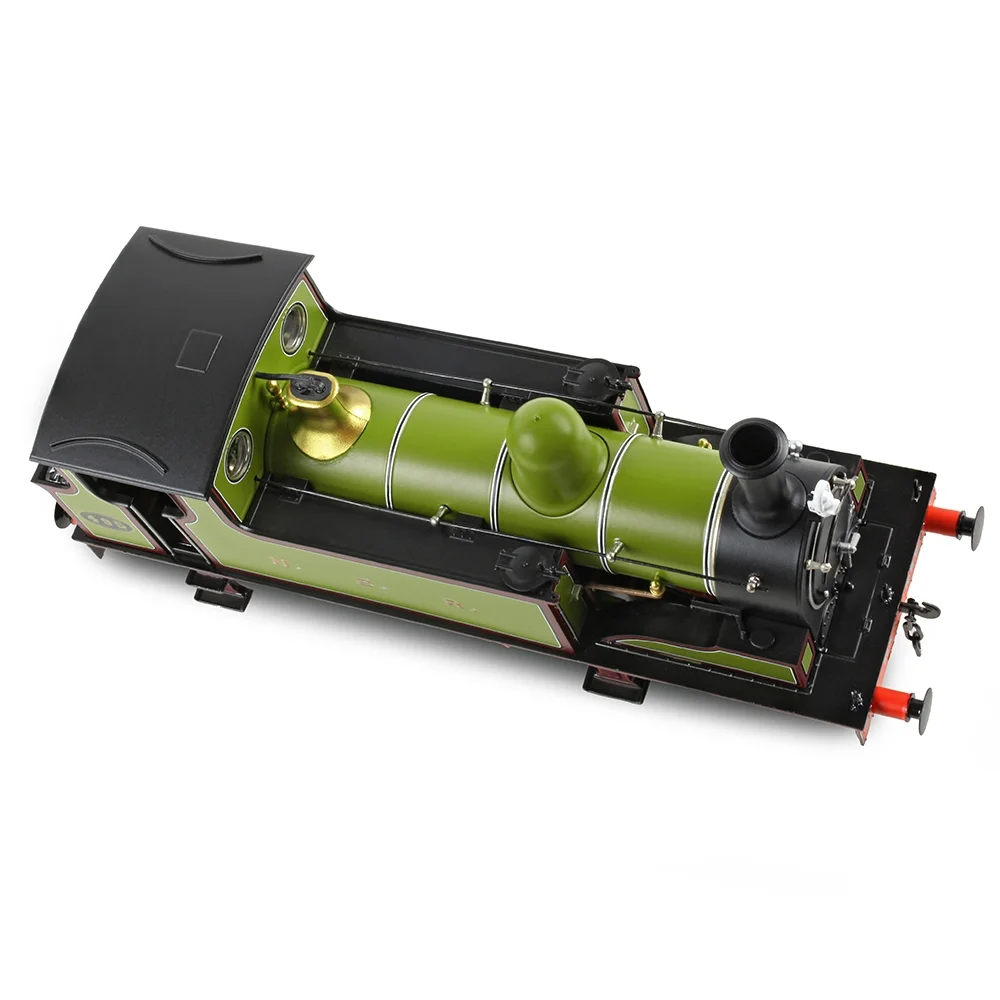Bachmann 31-065
North Eastern Railway Class E 495 North Eastern Railway Lined Green & Maroon
Bachmann's Description & Specifications
The North Eastern Railway E Class 0-6-0T, later the LNER J71, was the forerunner to the E1 (LNER J72) and whilst models of the E1 have famously been made by Bachmann and its predecessor Mainline Railways for almost 50 years, the NER E Class has never been produced in OO Scale, until now!
Drawing inspiration from the all-new Branchline E1 model that was launched to great acclaim just a few years ago, the new E Class employs a wealth of new tooling to accurately depict the NER’s original standard 0-6-0 tank locomotive. Despite the similarities, the E Class is instantly recognisable thanks to its larger driving wheels, while the smaller bunker means that the tanks, cab and bunker on this Branchline model are all-new too. Then there is the original boiler with clack valves and Ramsbottom safety valves – another early feature that necessitates its own, dedicated tooling.
The model boasts a diecast metal running plate with integral tank weights, again produced new for the E Class to portray the differences seen between the E and E1, and to this the precision moulded components are added, from the tanks to the boiler and many smaller details alongside. Metal parts are then used to replicate features like the lamp irons, guard irons and sand pipes, and the handrails are made from metal wire which is fitted into turned metal knobs.
Inside, the Branchline E Class employs a coreless motor with diecast gearbox and the driving axles each have separate metal bearings, a combination that ensures smooth and reliable running. With electrical pickup from all wheels, a firebox lighting system and Next18 DCC interface, plus a pre-fitted speaker in every model, the E Class boasts the same impressive technical specification as its E1 relative. Whilst the drive train and electronics may not be visible, every part of the model that can be seen is treated to an exquisite paint finish to complete the look, with rich colours and precision printing of the numbering and lettering to produce a model as elegant as its Victorian prototype.
- Bachmann Branchline OO Scale
- Era 2
- Pristine NER Lined Green & Maroon Livery
- Running No. 495
- Equipped with a Next18 DCC Decoder Socket – Recommend Decoder item No. 36-567A
- Length 118mm (over couplings)
DETAIL VARIATIONS SPECIFIC TO THIS MODEL
- Boiler Clack Valves
- Ramsbottom Safety Valves
- Bell Whistle
- Steam Brakes Only
- Plain Smokebox Door
- Twin Smokebox Door Handles
- Parallel Shank Buffers with Round Mounts
- Original Bunker without Coal Rails
- Rear Cab Windows without Bars
MECHANISM:
- Coreless motor
- Electrical pickup from all wheels
- Separate metal bearings fitted to each driving axle
- Diecast metal chassis block
- Diecast metal gearbox, with gearing arranged for prototypical running speeds and haulage capabilities
- 5mm (OO gauge) wheels to NEM310 & NEM311 standards with authentic profile and detailing
- Detachable coupling pockets to NEM362 standards fitted at each end
- Designed to operate on curves of second radius (438mm) or greater
DETAILING:
- Diecast metal running plate with integral side tank weights
- Precision moulded plastic boiler, side tanks, cab and bunker
- Separately applied details including splashers, tank filler hatches, safety valves, dome and chimney, smokebox handles, clack valves* and vacuum pipes* (*where applicable)
- Individual metal detail components including handrails, handrail knobs, guard irons, lamp irons and turned metal whistle
- Highly detailed and decorated cab interior including controls, dials, gauges and tool cabinets with separately fitted regulator, reverser and handbrake
- Running gear detailing includes springs, brakes and separately fitted brake gear, sandboxes and sandpipes
- Glazed cab spectacles
- Sprung metal buffers
- Each model supplied with an accessory pack including cab doors, additional bufferbeam pipework, poseable lamps and three-link couplings
LIGHTING:
- Firebox Glow (on analogue) / Firebox Glow & Flicker (on DCC or when SOUND FITTED models are used on analogue)
DCC:
- Next18 DCC decoder interface
SOUND:
- Speaker installed in all models for optimum sound reproduction
- ESU Loksound Micro V5DCC Sound Decoder fitted to SOUND FITTED versions
- Sound files produced specifically for the Bachmann Branchline J71 using recordings from real locomotives
- SOUND FITTED models operate on DCC and Analogue control as supplied
LIVERY APPLICATION:
- Authentic liveries applied to all models
- Multiple paint applications employed on each model
- Logos, numerals and text added as appropriate using multi-stage tampo printing incorporating authentic typefaces, logos and colours
Class & Prototype
- Class: North Eastern Railway Class E
- Traction: Steam
- Built: 1886-1895
- Total Built: 120
- Running Number: 495
- Ordered By: North Eastern Railway
- Built By: North Eastern Railway
- Built At: Darlington
- Built: 09/1889
- Withdrawn: 04/1959
- Length of Service: 69.6 years
- Running Numbers: NER 495, LNER 8250, BR 68250
- Names: -
The North Eastern Railway Class E was T.W. Worsdell's highly successful 0-6-0T shunting locomotive, introduced in 1886 to replace aging Fletcher saddle tanks. With 120 built at Darlington Works between 1886-1895, these compact side-tank engines became the backbone of NER freight operations from Durham coalfields to Tyne docks.
Featuring 4ft 7¼in driving wheels, 16in × 22in inside cylinders, and 140 psi boiler pressure, the Class E prioritized reliability over complexity with simple Stephenson valve gear. The design proved exceptionally durable - the last example served 74 years until 1961, making it one of Britain's longest-serving locomotive classes.
Under the LNER they became Class J71, with 81 surviving to British Railways as numbers 68230-68316. Their robust design directly inspired the famous J72 class, creating a locomotive lineage spanning 1886-1951.
Built in September 1889 at Darlington Works during the second production batch, No. 495 achieved historical significance beyond its operational service through its documentation in railway literature. The locomotive was selected by respected NER historian Ken Hoole for inclusion in his authoritative publications, where it appears alongside No. 50 in official weight diagrams and technical illustrations on pages 125-126 of his North Eastern Railway locomotive studies.
This documentation was crucial as it preserved authentic visual records of the locomotive in its original T.W. Worsdell livery - the distinctive lined green and maroon scheme that characterized NER locomotives of the 1880s-1890s. Unlike many contemporaries that were only photographed in later LNER or BR condition, No. 495's inclusion in these reference works provides verified details of period-correct buffer styles, lamp brackets, livery application, and technical specifications.
Operationally, No. 495 served for 69.6 years, being renumbered to LNER 8250 in 1946 and BR 68250 in 1948, before withdrawal in April 1959. As a standard example with 4ft 7¼in driving wheels and 16in × 22in cylinders, it represented the typical Class E configuration that influenced the later J72 design.
Model Selection Rationale: Bachmann chose No. 495 specifically because of this historical documentation, making it the only Class E locomotive with verified reference material for authentic Victorian-era NER livery recreation. This scholarly foundation ensures the model accurately represents the original T.W. Worsdell aesthetic rather than relying on speculation or later photographic evidence.
Operator & Livery
- Operator: North Eastern Railway
- Livery: Lined Green & Maroon
- Era: 2 - Pre-grouping
The North Eastern Railway dominated Britain's industrial north-east, operating the country's most profitable coal-carrying network across Yorkshire, Durham and Northumberland. Formed in 1854 from four constituent companies, the NER achieved a near-monopoly over regional rail traffic, handling over 50 million tons of minerals annually at its peak.
The railway pioneered British electrification with the 1904 Tyneside suburban scheme and experimental freight lines. Under chief mechanical engineers Wilson Worsdell and Vincent Raven, the NER developed distinctive locomotive designs including successful Atlantic express engines, innovative three-cylinder mixed-traffic locomotives, and robust freight classes that served until the end of steam in 1967.
Notable achievements included building the world's largest station at York (1877), completing the East Coast Main Line, and operating extensive dock facilities. The company's engineering excellence earned recognition during World War I when Vincent Raven supervised munitions production at Woolwich Arsenal.
The NER merged into the London and North Eastern Railway in 1923, but its locomotive designs continued in production well into the British Railways era. Today, the railway's legacy lives on through preserved locomotives, heritage railways, and comprehensive model ranges available in all popular scales, making NER subjects ideal for authentic British railway modelling.
The North Eastern Railway's distinctive locomotive livery evolved from chaos to elegant standardisation under T.W. Worsdell in 1885. Prior to this date, the company's various workshops at Gateshead, Darlington, York, and Leeds each applied their own variations of light green schemes, creating a patchwork of colours across the fleet. Worsdell's standardised livery featured a beautiful light green body colour (now known to modellers as "Saxony Green") combined with rich red-brown frames and valances that created a striking two-tone appearance. The scheme was completed with black boiler bands edged in white, giving passenger locomotives an elegant and distinctive appearance that stood out among Britain's pre-grouping railways.
This attractive livery remained standard for NER passenger locomotives from 1885 until 1903, when goods locomotives were switched to a more practical black finish with vermilion lining. The combination of light green and maroon proved both distinctive and practical, as the darker frames helped disguise the inevitable grime from coal dust and ash while maintaining an elegant appearance for premier passenger services.





